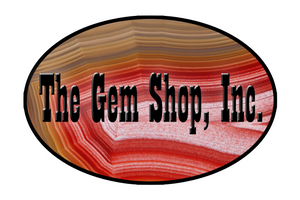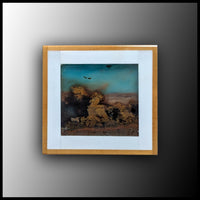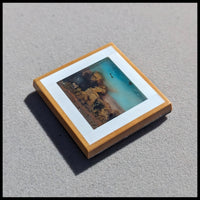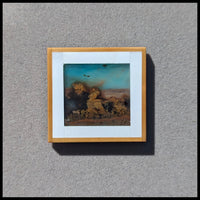This polished intarsia contains multiple layers of stone, with the center containing Montana Moss Agate, Del Norte Plume Agate, Peruvian Blue Opal, and Turquoise; completed with a double border frame and black backing. The cabochon is constructed from 13 individual pieces.
A complex and detailed scene is created through the multiple layers and colors that overlap in this intarsia cabochon. The turquoise backing adds saturation to the semi-translucent Blue Opal layer, creating a vibrant sky with a natural gradient. The same Blue Opal layer's lower half contains a tan and pinkish matrix. This forms a distant landscape, and gives the next layer a neutral base for where the ground lays. Del Norte Plume Agate creates this foreground, with dense foliage in warm yellows and dark brown. The final layer of the center is a piece of very clear Montana Moss Agate, with specks of dendrites showing birds soaring in the sky.
Montana Moss Agate
Del Norte Plume Agate
Peruvian Blue Opal
Turquoise
Black Basalt
Border:
White Agate
Wildhorse Picture Jasper
35mm x 36mm
Intarsia: The Gem Shop’s founder, Eugene Mueller, has an MFA in painting and has won awards in the Cutting Edge Competition® for his intarsia, and has crafted and/or designed many of the pieces available here. For thousands of years artisans have been using stone, striving to create the most beautiful scene possible. This process is commonly referred to as Intarsia. Intarsia traces its history back to the Italian Renaissance, and was called pietra dura. This is a term for the inlay technique of using thinly cut and polished stones to create images. The stonework is glued stone-by-stone to a substrate after having previously been sliced and cut in different shape sections; and then assembled together so precisely that the contact between each section is practically invisible. Intarsia items are generally crafted on green, white or black base stones. Traditionally Intarsia pieces have a flat polish, but more contemporary pieces are more freeform and have a dome polish, and are often referred to as “composite cabochons.” Intarsia is a high expression of lapidary art requiring a close mastery. Each piece is eccentric and highly collectible – a true work of art.






